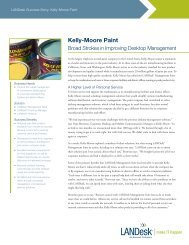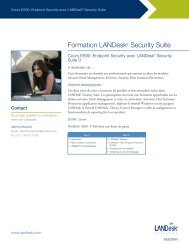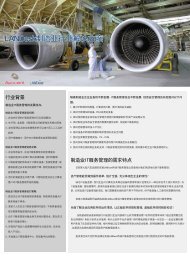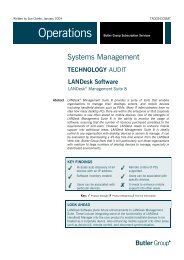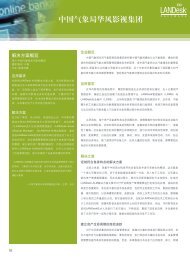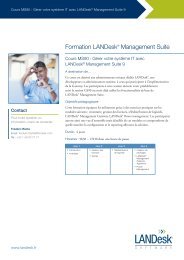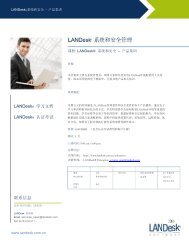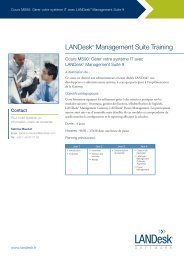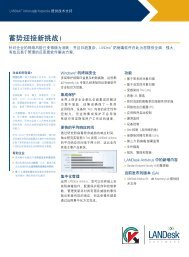Download the University of Mississippi Medical Center ... - LANDesk
Download the University of Mississippi Medical Center ... - LANDesk
Download the University of Mississippi Medical Center ... - LANDesk
Create successful ePaper yourself
Turn your PDF publications into a flip-book with our unique Google optimized e-Paper software.
coNTiNUEd fRoM fRoNT PaGE Ò<br />
Stem-cell <strong>the</strong>rapy could thwart ‘ischemic cascade’ in <strong>the</strong> brain<br />
The UMMC Comprehensive Stroke <strong>Center</strong> is one <strong>of</strong> 10 U.S. sites enrolling<br />
a total <strong>of</strong> 120 patients into <strong>the</strong> study. The center aims for about 12 from <strong>Mississippi</strong>.<br />
Dr. Alexander P. Auchus, pr<strong>of</strong>essor and McCarty Chair <strong>of</strong> Neurology at<br />
UMMC, serves as principal investigator for <strong>Medical</strong> <strong>Center</strong>’s portion <strong>of</strong> <strong>the</strong><br />
clinical trial.<br />
“These are pluripotent stem cells derived from adult bone marrow,”<br />
Auchus said. “No fetal or embryo-derived cells were used in making this<br />
treatment.”<br />
“Pluripotent” means <strong>the</strong> cells can transform into many different types <strong>of</strong><br />
tissue: bone, muscle, connective tissue and more. That ability makes stem<br />
cells promising for a wide range <strong>of</strong> medical treatments.<br />
But for biomedical scientists, precise control and manipulation <strong>of</strong> <strong>the</strong> cells’<br />
pluripotency has proved difficult in some circumstances.<br />
“All AdulTs hAve A sMAll AMouNT <strong>of</strong> stem cells in <strong>the</strong>ir bone<br />
marrow,” Auchus said. “These were removed from a donor, grown in culture,<br />
frozen and distributed to <strong>the</strong> participating centers.”<br />
Study participants get randomized into ei<strong>the</strong>r a control group, which<br />
receives a harmless placebo, or <strong>the</strong> test group, which gets <strong>the</strong> experimental<br />
<strong>the</strong>rapy. At UMMC, Bone Marrow Transplant Lab personnel prepare <strong>the</strong><br />
injections.<br />
“This is a collaboration between many players,” said Tereza Holman,<br />
BMT Lab director. “This is more <strong>of</strong> a straightforward procedure for us than<br />
our normal processing <strong>of</strong> peripheral blood stem cells and bone marrow for<br />
transplants.<br />
“But at <strong>the</strong> same time, a clinical trial like this could not have been done if<br />
<strong>the</strong>re wasn’t a lab trained in <strong>the</strong>se preparations.”<br />
Auchus said after a patient consents, <strong>the</strong> person ei<strong>the</strong>r gets injected with a<br />
placebo or 2.4 million stem cells in solution, all in one infusion, given over an<br />
hour. The stem cells circulate through <strong>the</strong> patient’s bloodstream.<br />
Brain cells in <strong>the</strong> stroke-injured area deploy signaling molecules known as<br />
cytokines that flag down <strong>the</strong> stem cells. The stem cells – like icing a twisted<br />
ankle – may keep <strong>the</strong> injured brain tissue from<br />
inflammation, Auchus said.<br />
“This is not about removing <strong>the</strong> clot,” he<br />
said. “It’s about keeping <strong>the</strong> brain from swelling,<br />
getting irritated and causing fur<strong>the</strong>r damage as<br />
<strong>the</strong> area deprived <strong>of</strong> blood flow reacts.”<br />
That domino effect, called an ischemic cascade,<br />
can trigger more severe paralysis, speech<br />
and cognitive problems and leave <strong>the</strong> patient<br />
weaker and more vulnerable to greater injury or<br />
death from ano<strong>the</strong>r stroke.<br />
Holman<br />
<strong>Mississippi</strong> rANked 46Th in <strong>the</strong> nation for stroke deaths between<br />
2005 and 2007, according to <strong>the</strong> American Heart Association. With 128,842<br />
lives lost in 2009, stroke continued as <strong>the</strong> nation’s fourth-leading cause <strong>of</strong><br />
death behind heart disease, cancer and chronic lower respiratory diseases,<br />
according to <strong>the</strong> <strong>Center</strong>s for Disease Control and Prevention.<br />
Unhealthy lifestyles, including obesity, tobacco use, hypertension and lack<br />
<strong>of</strong> exercise, contribute to stroke’s likelihood, along with genetic factors.<br />
Stroke remains a frustrating illness for physicians, Auchus said. In<br />
standard treatment, patients are assessed in an emergency room, get CT scans<br />
from a radiologist and receive a clot-busting medication in consult with a<br />
neurologist.<br />
“The only clot-busting medication is FDA-approved for use up to three hours<br />
from symptom onset but is commonly used up to four-and-a-half hours from<br />
onset,” Auchus said.<br />
If <strong>the</strong> clot lodges in a reachable blood vessel, neuro-interventionalists can<br />
insert an image-guided ca<strong>the</strong>ter into <strong>the</strong> artery to poke, pop or remove <strong>the</strong><br />
blockage. Ca<strong>the</strong>terization is considered viable for up to about six hours following<br />
onset. After ca<strong>the</strong>terization, <strong>the</strong> patient moves to a neuro-ICU, where<br />
specialists treat and monitor progress.<br />
Auchus welcomed new options, saying stem-cell <strong>the</strong>rapy could extend <strong>the</strong><br />
treatment window to 30 hours after symptoms begin.<br />
Ohio-based biotech researcher A<strong>the</strong>rsys developed <strong>the</strong> experimental<br />
<strong>the</strong>rapy and organized <strong>the</strong> trial. If this phase II trial proves effective, A<strong>the</strong>rsys<br />
will start a phase III trial with about 600 patients.<br />
“They wouldN’T hAve piCked us if we didn’t have <strong>the</strong> expertise,”<br />
Auchus said <strong>of</strong> <strong>the</strong> Comprehensive Stroke <strong>Center</strong>.<br />
Last year <strong>the</strong> center admitted more than 500 patients for stroke. Regardless<br />
<strong>of</strong> whe<strong>the</strong>r patients enroll, and which injection participants receive, all<br />
patients get <strong>the</strong> stroke center’s standard <strong>of</strong> care, he said.<br />
Study participants receive follow-up MRIs from <strong>the</strong> Department <strong>of</strong> Radiology<br />
to examine <strong>the</strong> size <strong>of</strong> <strong>the</strong> stroke, and exams for function and strength at<br />
seven days, one month, three months and one year.<br />
Auchus said not all stroke patients will qualify for <strong>the</strong> trial. Among o<strong>the</strong>r<br />
factors, candidates must have no cancer history, have <strong>the</strong>ir spleen and <strong>the</strong>y<br />
must be enrolled within 30 hours <strong>of</strong> <strong>the</strong> onset <strong>of</strong> symptoms.<br />
<strong>Mississippi</strong>’s first participant in <strong>the</strong> study arrived at Forrest General within<br />
two hours <strong>of</strong> symptom onset, received <strong>the</strong> clot-buster drug and was transported<br />
via helicopter to UMMC, a procedure commonly called “Drip ‘n Ship.”<br />
For those reasons <strong>the</strong> Clarke County patient was a good candidate, Auchus<br />
said. Thanks to UMMC’s AirCare, <strong>the</strong> patient arrived at <strong>the</strong> <strong>Medical</strong> <strong>Center</strong>’s<br />
Emergency Department five hours after onset.<br />
“This is more <strong>of</strong> a straightforward procedure for<br />
us than our normal processing <strong>of</strong> peripheral blood<br />
stem cells and bone marrow for transplants.”<br />
— Tereza Holman<br />
“We considered putting in a ca<strong>the</strong>ter but imaging showed us <strong>the</strong> clot<br />
was too far away,” Auchus said. “Although <strong>the</strong> clot was out <strong>of</strong> reach, <strong>the</strong><br />
brain’s reaction to loss <strong>of</strong> blood flow was still within <strong>the</strong> realm <strong>of</strong> treatment.”<br />
The patient, with family support, decided to enroll in <strong>the</strong> clinical trial.<br />
Following standard and trial treatments <strong>the</strong> patient left <strong>the</strong> neuro ICU on day<br />
three with some minor weakness as <strong>the</strong> only residual deficit.<br />
“The family was glad to have a center where <strong>the</strong> patient had options,”<br />
Auchus said. “And <strong>the</strong> patient is home and continues to improve.”<br />
June 25, 2012 | cENTERVIEW<br />
7<br />
CENTERVIEW



